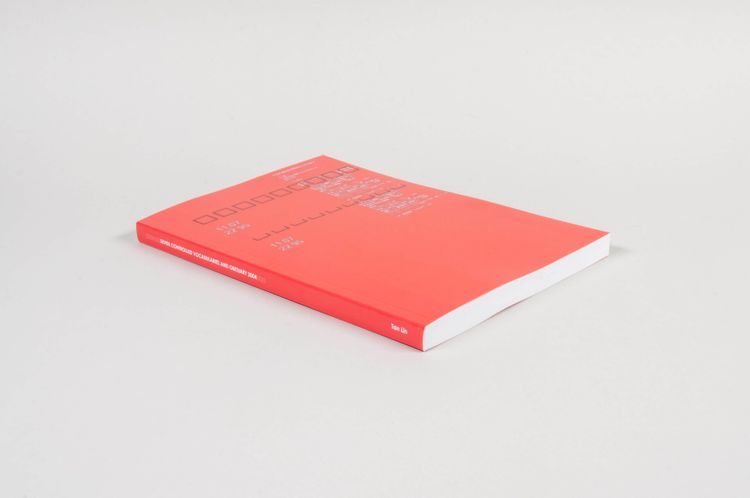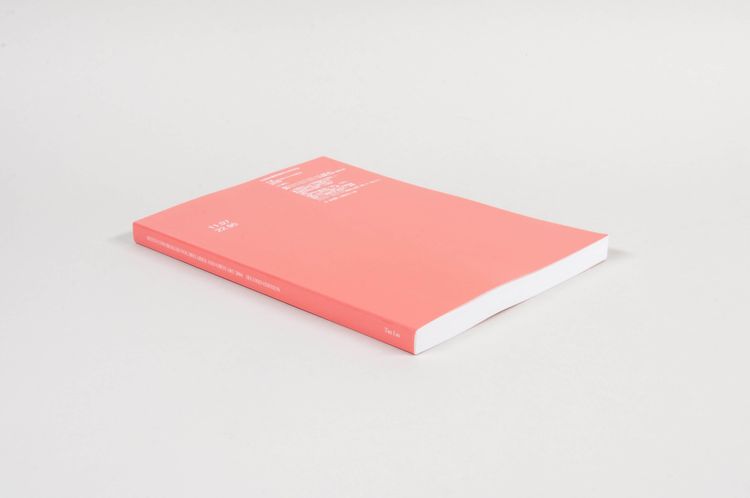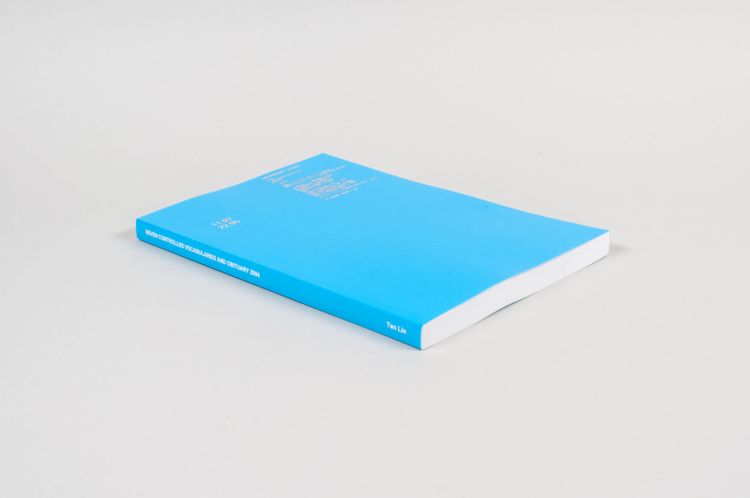11 Books Expanding Tan Lin’s Seven Controlled Vocabularies and Obituary: The Joy of Cooking, 2010
This eleven-piece series launched by Danny Snelson’s Edit Publica tions expands Tan Lin’s Seven Controlled Vocabularies and Obituary: The Joy of Cooking, 2004 (Wesleyan Poetry Series, 2010). It involves around fifty poets and derives from an event at the Kelly Writ ers House at the University of Pennsylvania on April 12, 2010, titled Handmade book, PDF, lulu, Appendix, Powerpoint, Kanban Board/ Post-Its, Blurb, Dual Language (Chinese/ English) Edition, micro lecture, Selectric II interview, wine/cheese reception, Q&A (xerox), film. The event itself never included all the aspects mentioned in its title.
The series was based on the hypothesis that “editing is the new semiotics, partly meaning that editing crosses into numerous disciplines connected to writing, artistic practice, book making, social networks, and distribution, etc., in the way that semiotics did with cultural an- thropology, literary studies etc etc...” (Tan Lin, Danny Snelson, Kristen Gallagher, “Notes on an Edit Event”). In their notes, which opened the wiki for the event, the editors further elaborate that it “involved making [...] certain forms of reading visible. The gesture involved taking a book (7CV) from an author [...] and putting it in the hands of its readers (editors). I didn’t want to make editorial practices merely labor intensive or parasitical, vis-à-vis the standard reworking of a source text. Instead, the event encouraged practices (temporal events very much subject to endurance issues) that would situate the so-called textual object in a literal and technological field that included citing sources (Appendix and Bibliography), rewriting the text (Chinese Edition), listing devices, reading the text alongside other texts (Critical Reader), and evaluating its production (Selected Essays)—all of which were read within a number of on-the-fly editorial frameworks” (Ibid.).
The publications were deliberately produced under time pressure, resulting in decisions and errors that made “the editorial process more visible and render[ed] the book as an emendation in a larger communicative envelope” (Ibid.). All publications are available as free downloads and can also be purchased through print-on-demand on Lulu, but also through Printed Matter (New York), which serves as a collaborative partner along with the University of Pennsylvania and Kelly Writers House.
This positive print-on-demand experience was decisive for Danny Snelson’s later series 1,000 Books by 1,000 Poets for the exhibition “Poetry will be made by all!” in Zurich, 2014.

Blurb contains sixty blurbs on Tan Lin’s 7CV and forty-eight photos depicting the authors of these blurbs. In this way, it takes up the compositional style of 7CV, which also consists mostly of paratextual matter. At the same time, it shows the enormous, liberating, and inspiring impact that Lin’s book had for the US poetry scene. Many blurbs in this book are probably serious, comparing Lin’s book to Andy Warhol’s a: A novel and enthusing about its innovative poetics, as here:
“A brilliant manifesto for conceptual, ambient writing, for non-reading.” Some highlight its unusual character: “If this is a book, then I am an angel,” or adopt a poetic or experimental character themselves. Others mirror the typical excessive tone of blurbs, parodying the text type and related marketing mechanisms on the book market. In between, there are also statements such as “I wrote this book.” The blurb collection appropriately ends with, “The best way to become acquainted with 7CV is to write a book about it.”
Edited by Matthew Abess, Patrick Lovelace, Stephen McLaughlin, and Danny Snelson.
Christopher Alexander, Louis Asekoff, Stan Apps, Danielle Aubert, Charles Bernstein, E. Shaskan Bumas, Ken Chen, Cecilia Corrigan, Clare Churchouse, AMJ Crawford, Kieran Daly, Mónica de la Torre, Thom Donovan, Patrick Durgin, Kareem Estefan, Robert Fitterman, Jonathan Flatley, Peter Fong, Christopher Funkhouser, Kristen Gallagher, Sarah Gambito, Kenneth Goldsmith, Diana Hamilton, Eddie Hopley, Paolo Javier, Josef Kaplan, John Keene, Matthew Landis, Juliette Lee, Maya Lin, Warren Liu, Patrick Lovelace, Rachel Malik, Dan Machlin, Michael Ondaatje, Asher Penn, Josiah McElheny, Stephen McLaughlin, Jay Sanders, Katherine Sanders, Jeremy Sigler, Danny Snelson, Chris Sylvester, Gordon Tapper, Michele Taransky, Dan Visel, Dorothy Wang, and Sara Wintz.

7CV: Critical Reader is a collection of publications situating Tan Lin’s Seven Controlled Vocabularies and the media practices it implies in a broader theoretical context. It lists 143 publications ranging from media philosophy and literary studies to sociology, urbanism, the history of art, digital cultures, and more, also including instances of poetry and fiction. The listed publications are sorted in twenty-two topical chapters and represented by a bibliographical note and reproductions of one relevant paragraph each.
The reader was edited by Mashinka Firunts and Danny Snelson with Chris Cuellar as guest editor, and Eddie Hopely and Sueyeun Juliette Lee as event editors, emphasizing the need for collectivity in creating such extensive bibliographic overviews.
Yet, 7CV: Critical Reader not only works as an annotated and thematically assorted bibliography and reader but also as an interface for a pirate library, as all publications include links to downloadable digital copies of the texts. The files, however, have been uploaded to a one-click hoster that no longer exists, and they are therefore not available anymore, underlining how such digital archival approaches that are looking for distribution loopholes of copyrighted material are also always subject to the online economies they are situated in.
7CV: Critical Reader was conceived and published during a republication event at the University of Pennsylvania.

This volume contains essays (max. 600 words) by forty-seven contributors on technology, tools and concepts related to writing, translating, publishing and editing, such as select bibliographies, font libraries, Facebook, Blurb, metadata, scanning, artist’s books, poetry workshops, PowerPoint, IBM Selectric II, Xerox, Microsoft Word, errata, pagination, barcodes, and indexes. For some subjects there are several essays. They are arranged according to the order in which the essays were received by the seven-member editorial team during the event, who immediately edited and printed them as an on-site publication. “Lack of an authoritative list of essays/essayists by event’s end, absence of a wiki style sheet, and non-codified editorial practices rendered the history of publication Just Good Enough, as attested by its principal formats: the wiki and lulu edition. [...] The Selected Essays might be regarded as performance-based publishing event, wiki, POD mechanism, social network, archive of search results, and tag collection. Genres are social agreements, as are search terms” (J. Gordon Faylor, Danny Snelson, “Editorial Note,” 7). Cover design by J. Gordon Faylor.

This is the first edition of the (traditional) Chinese translation of Lin’s work, which was produced entirely by Google Translate on-site at the event. The visuals have been lost, which is why there is excessive white space. Ten pages have been left completely blank, where Lin’s original contains book pages scanned and reproduced as images, which apparently could not be recognized and translated as text by Google Translate. The only English-language text is the “Editorial Note” by Tan Lin. The “On line/Google Trans work team” consisted of Chris Alexander, Alejandro Crawford, and Cecilia Corrigan.

This second translation into (traditional) Chinese was also produced with the help of Google Translate, but after the event “in transit from Philadelphia to New York City and in Woodside, Queens and on the internet” (colophon). In addition, the visuals that were lost in the first translation were reinserted, the page count was corrected, missing text was added, existing text was reformatted, and the front matter was rearranged “to correspond to the Wesleyan University Press (American English) first edition” (Ibid.). The only English-language texts are the “Editorial Note” by Tan Lin, the text on the scanned book pages, and the colophon.

This is the third translation (with the visuals) by Google Translate, but this time from traditional Chinese to simplified Chinese. The colophon informs that this caused “a higher rate of error in conjunction with the limited character set of MS Gothic, causing many of the characters to ‘disappear.’” On pages 24 and 32, the Chinese text was replaced by the phrase: “‘Sorry, the page you requested contains a file type (application/octetstream) we are unable to translate.’ This phrase was produced by feeding the Wesleyan UP TIFF files containing the Chinese text into Google Translate using the ‘upload a document’ feature” (colophon).

This final volume contains the reverse translation from traditional Chinese of the second edition into English and includes the visual material. The two error messages from the third edition have been retained and translated into traditional Chinese.

This book is an inventory, map, and documentation of the tools, software, resources, people, contributions, and publications connected with the event. All devices are also documented individually as photos, such as IBM Selectric typewriter, Post-It notes, SanDisk 4GB USB flash drive, Sony ICD-UX70 digital voice recorder, Anchor ANX-70 monitor speakers, Sony EVI-D70 digital camcorder, Office Depot copy paper, Canon Pixma MP210 all-in-one inkjet, Mackie 1402-VLZ PRO 14-channel mixer, and 12 different notebooks. The photos were taken by Jeremy J. F. Thompson, who also provided layout and cover design. The cover’s mind map visualizes the coordination of tasks related to the event.
There are PDF and EPUB versions of this inventory, as well as a polychromatic (ISBN 9780557517992) and monochromatic (ISBN 9780557518104) printed edition, which differ significantly in price (according to the covers, $27 and $8.11 respectively). As an exception, we bought both versions for comparison.

The Appendix, which contains additional material like a draft version of the cover design, a QR code, and PR texts, is under the authorship of Tan Lin according to the colophon, but was arranged and approved by Danny Snelson. Lin also contributed “The Expanded Preface,” and Snelson an “Introduction” consisting only of rows of the letter “x.” There are also two interviews in which Tan Lin gives detailed information about his poetics and 7CV, as well as several indexes, created by Lin, Snelson, Lawrence Giffin, and Ashley Leavitt, which either record persons, titles, and objects as is customary for an index, or alternatively provide an index of first lines or simply register blank pages, barcodes, parentheses, numbers, Chinese characters, quotation marks, and so on. In this way, the Appendix mirrors the importance attributed to the index in the wiki of the event: “Why would a poetry book require an Index, which is normally used for non-fictional works? What makes that condition relevant and somehow necessary today? I think all books of poetry should have indexes not written by the author!” (Tan Lin, Danny Snelson, Kristen Gallagher, “Notes on an Edit Event”)
This unconventional approach continues in the “Afterword” by Charles Bernstein, which he took from a single found source, and Lawrence Giffin’s “Select Bibliography,” which “lists all work consulted in the [event] period in question, related to the production of an Appendix to another work in question.” In addition, the Appendix contains documents and information that rarely see the light of day, such as the two positive reader reports that were instrumental in Wesleyan University Press accepting 7CV for publication, and the publishing contract.

